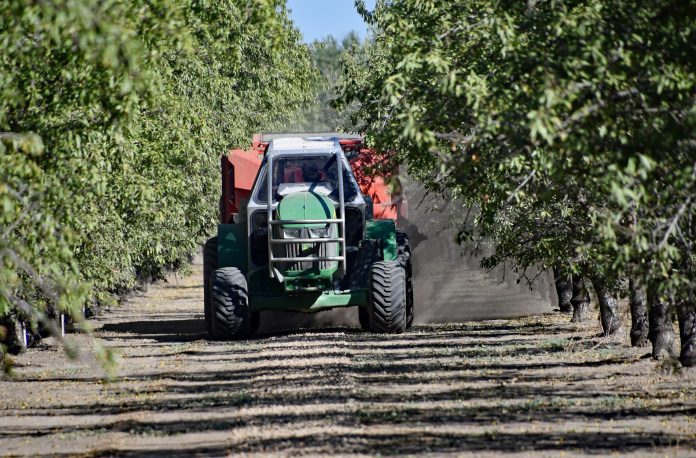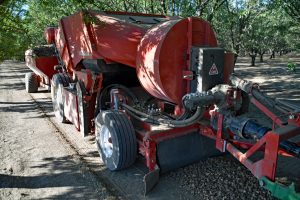
The San Joaquin Valley Air Quality Control District has helped replace more than 180 conventional nut harvesters with low-dust models since its focused replacement program was piloted in 2018. The Natural Resources Conservation Service has a separate program that provides per-acre cost-share to growers who have orchards custom-harvested with low-dust equipment. It also offers incentives to growers who harvest their own orchards with low-dust machines and are bringing new trees into production.
Together, the programs are designed to help reduce the state’s air quality problems surrounding minute dust particles known as PM 2.5.
A Focus on the San Joaquin Valley
The Valley Air District’s program provides up to 50% of the purchase price, or up to $150,000 apiece, for an approved PTO-driven or self-propelled low-dust nut harvester. Applicants who receive district cost-share for nut harvesters cannot receive additional funding from other local, state or federal programs. But they’re allowed to receive air district incentives on up to five harvesters.
“It’s very popular with the producers out there and the custom harvesters as well, so it’s been very successful,” said Aaron Tarango, air district program manager for the grant department.
On average, recipients have received about $90,000 per unit, he said. For this fiscal year, which began July 1, the district budgeted $2 million for the program.
This harvester program is only for machines that operate within the Valley Air District, which covers the valley portion of Kern County to San Joaquin County in the northern part of the valley. To qualify, each low-dust harvester model has had to be tested and shown to reduce dust production by at least 40% compared to conventional machines.
A Beneficial Incentive
Roger Isom, president and CEO of Western Agricultural Processors Association, said he would like to see more funding put toward low-dust harvesters. But he also understands the Valley Air District’s priorities of reducing nitrogen oxide (NOx) emissions from off-road engines.
“[The harvester program] has been very beneficial because growers don’t have the money the way commodity prices are right now; they need that incentive,” he said. “Probably the bigger issue, frankly, has been the need to focus most of the air district’s funds on tractor replacement because we need to meet the federal goals by 2023.”
As a part of recent attainment planning efforts for the federal PM 2.5 standards, the state committed to reduce 11 tons per day of NOx and 0.58 tons per day of PM 2.5 from agricultural equipment in the San Joaquin Valley by the 2024 deadline.
To that end, the district this fiscal year allocated $189 million toward the replacement of agricultural tractors with Tier 0, Tier 1 and Tier 2 engines.
NRCS Cost-Share Program
NRCS also offers cost-share for low-dust nut harvest equipment through the Environmental Quality Incentive Program. But the federal program is slightly different than the state’s, said Jesse Bahm, NRCS state air quality specialist.
For the 2022 season, NRCS provided $42.84 per acre annually as part of a three-year contract for almond orchards statewide in which low-dust harvesting equipment is used. The rate for 2023 is expected shortly.
To qualify, he said the equipment must reduce PM 2.5 and PM 10 dust production by at least 30% compared to conventional machines.
“I always encourage producers to come in and apply, and we can see how our programs work for them,” Bahm said.

Dust Reduction Goals
Because the San Joaquin Valley is an EPA non-attainment area for PM 2.5 particulate matter, the goal of the nut harvester replacement programs is to reduce dust produced during nut harvest.
With a diameter about 30 times smaller than a human hair, PM 2.5 particulates have come under fire because they can be inhaled into the lungs, potentially causing premature death and heart and lung issues. Together with the slightly larger PM 10 particulates, they also can reduce visibility.
In addition, the Almond Board of California has established an industry-wide goal of reducing dust during the entire harvest process by 50% by 2025 as part of its “Almond Orchard Goals 2025 Roadmap” released in December 2019.
For Valley Air District harvester-replacement applicants on the fence, Tarango encouraged them to apply sooner rather than later.
“It’s been over-subscribed, which is a good thing to have because it means they’re interested in doing it,” Tarango said.
For those opting for a PTO-driven low-dust harvester, he said they must have a Tier 3 or Tier 4 tractor with which to pull it. If they have one rated as Tier 0, 1 or 2, they’d have to replace it with a Tier 4 final tractor to also take advantage of the nut harvester program.
However, Tarango pointed to the district’s agricultural tractor replacement program that will help fund lower-emissions tractors.
“We cannot fund a new PTO low-dust harvester unless the tractor pulling it is at least a Tier 3,” he said. “If you don’t currently have a Tier 3 or cleaner tractor that can pull the new low-dust PTO harvester, then the district will help you replace it with a new Tier 4 final tractor. You can apply to both programs at the same time if you need to upgrade your old tractor as well.”
With both programs, Tarango said, the district contracts with valley dismantlers that render the older equipment inoperable and verify it has been destroyed.
For more information on the Valley Air District’s nut harvester replacement programs, visit valleyair.org/grants/low-dust-nut-harvester-replacement-
program/. To find the NRCS office nearest you, visit the office locator page at offices.sc.egov.usda.gov/locator/app.










